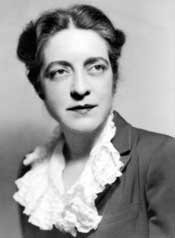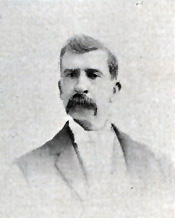
Annie Jump Cannon was an American astronomer whose cataloging work was instrumental in the development of contemporary stellar classification. With Edward C. Pickering, she is credited with the creation of the Harvard Classification Scheme, which was the first serious attempt to organize and classify stars based on their temperatures and spectral types. She was nearly deaf throughout her career. She was a suffragist and a member of the National Women's Party.

Thomas Hopkins Gallaudet was an American educator. Along with Laurent Clerc and Mason Cogswell, he co-founded the first permanent institution for the education of the deaf in North America, and he became its first principal. When opened on April 15, 1817, it was called the "Connecticut Asylum for the Education and Instruction of Deaf and Dumb Persons," but it is now known as the American School for the Deaf.

Melba Newell Phillips was an American physicist and pioneer science educator. One of the first doctoral students of J. Robert Oppenheimer at the University of California, Berkeley, Phillips completed her Ph.D. in 1933, a time when few women pursued careers in science. In 1935 Oppenheimer and Phillips published their description of the Oppenheimer–Phillips process, an early contribution to nuclear physics that explained the behavior of accelerated nuclei of radioactive hydrogen atoms. Phillips was also known for refusing to cooperate with a U.S. Senate judiciary subcommittee's investigation on internal security during the McCarthy era that led to her dismissal from her professorship at Brooklyn College, where she was a professor of science from 1938 until 1952.
The Louisiana School for the Deaf is a state school for deaf and hard-of-hearing students in Louisiana, located in Baton Rouge, the state capital. It was established in 1852 as a joint school for blind students. In 1860, its first purpose-built facility was completed and admired as an elegant monument to philanthropy. The schools were divided in 1898, and in 1908, Louisiana School for the Deaf was renamed.
The Kansas School For the Deaf, is a K-12 school, located in downtown Olathe, Kansas. In 1866, it became the first school for the deaf established in the state of Kansas, and today it remains the largest. Originally named the "Asylum for the Deaf and Dumb", the name has been changed several times to conform to prevailing sensibilities about deafness. Students and staff often refer to the school as "KSD."

Indiana School for the Deaf (ISD) is a fully accredited school for the deaf and hard of hearing, located in Indianapolis, Indiana.

John Hanna was a one- term United States Representative and United States Attorney from Indiana.

Jethro Ayers Hatch was an American physician and politician who served one term as a U.S. Representative from Indiana from 1895 to 1897.
Events from the year 1867 in the United States.

Margaret Hill McCarter was an American teacher and novelist. She was the best known and highest paid novelist in Kansas for her time.

John Daniel "Jack, Silent" Ulrich was a Canadian professional ice hockey right winger. Ulrich, who was deaf-mute, played professionally with the Vancouver Millionaires and the Victoria Aristocrats in the Pacific Coast Hockey Association in 1912–1914. He also played for the Montreal Wanderers and the Toronto Blueshirts in the National Hockey Association in 1914–1916.

Historical coats of arms of the U.S. states date back to the admission of the first states to the Union. Despite the widely accepted practice of determining early statehood from the date of ratification of the United States Constitution, many of the original colonies referred to themselves as states shortly after the Declaration of Independence was signed on 4 July 1776. Committees of political leaders and intellectuals were established by state legislatures to research and propose a seal and coat of arms. Many of these members were signers of the Articles of Confederation, Declaration of Independence, and United States Constitution. Several of the earliest adopted state coats of arms and seals were similar or identical to their colonial counterparts.
The following works deal with the cultural, political, economic, military, biographical and geologic history of the Midwestern United States.
Tanya Zolotoroff Nash was a Russian -American Deaf Rights activist who, after emigrating to the United States in 1904 from Ukraine, dedicated 35 years of her life advocating for, teaching, and creating safe spaces for the American Jewish Deaf and elderly deaf community. She held leadership in the Society for the Welfare of the Jewish Deaf as well as pushed for the creation of the New York State Mental Health Services for the Deaf (1955). Her legacy is upheld in New York's Tanya Towers Community Residence, which to this day stands and operates in her honor as a residence building for the elderly deaf community. This was her final project before retirement in 1968.
Levi Strong Backus (1803–1868) is widely considered the first deaf editor of America, if not the world. He ran a newspaper called the Radii.
Eleanor Sherman Font was hired as prints curator at the Hispanic Society of America before expanding into iconography. She was one of six women chosen by Archer Milton Huntington to deepen their knowledge in art curation for the Society after graduating from library sciences programs. Her great-grandfather is Thomas Hopkins Gallaudet, founder of the American School for the Deaf in Hartford. She was deaf and volunteered for deaf causes throughout her life. During her life, she participated in services at St. Ann's Church for Deaf-Mutes, where she "sang" in American Sign Language with others in the choir.
Mervin "Merv" Donald Garretson was an American educator, leader, and deaf community rights advocate. His works were primarily directed towards changing mainstream opinion about deaf culture and the deaf community's.

Olive Sanxay, also seen as Olive Sanxey, was an American poet and short story writer.
Elizabeth English Benson (1904–1972) was an American educator for deaf students who taught at Gallaudet College for two decades before being named Dean of Women there. During World War II, she temporarily joined the military so she could help newly deafened soldiers injured in the war. Later she was an occasional interpreter for two U.S. presidents.
Eugene "Silent" Hairston was the first American professional Black Deaf boxer. He was born in Harlem in 1929 and became deaf at 1 year old due to a case of spinal meningitis. Growing up, he went to P.S. 47 until he was 15, when he had to drop out to help support his family. He started boxing as an amateur in 1945, winning 59 out of his 60 matches. In 1947, Hairston became a professional boxer. During his time as a boxer, his most famous fight was against Jake LaMotta which ended in a draw. He was also the Golden Glove champion in 1947. In 1953, Hairston had to retire due to injuries. After his time as a boxer, Hairston worked for UPS.










